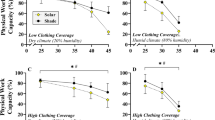Abstract
Different methods have been compared for the estimation of solar heat load on man. The comparison comprised several methods based on the calculation of absorbed solar radiation and one method for calculation of mean radiant temperature (Mrt). Regression analysis was carried out for predicted values and values calculated for a vertical cylinder, assumed as an analog model of a standing man. Regression of mean skin temperature, measured in 10 subjects exposed to solar radiation under a variety of climatic conditions, on predicted radiant heat load was also analysed. Mean skin temperature correlated best withMrt, accounting for more than 50% of the variance. The results indicated that three methods provide a realistic estimation of the radiation heat load, whereas some methods show deviations of several hundred per cent.
Similar content being viewed by others
References
Aizenshtat BA (1986) Health and the heat balance of the human body. Proceedings of Symposium on Climate and Human Health, Leningrad, pp 170–181
Blazejczyk K, Krawczyk B (1991) Influence of climatic conditions upon heat balance of the human body. Int J Biometeorol 35:103–106
Breckenridge JR, Goldman RF (1971) Solar heat load in man. J Appl Physiol 31:659–663
Breckenridge JR, Goldman RF (1972) Human solar heat load. Proceedings of ASHRAE Semiannual meeting, New Orleans, pp 65–69
Breckenridge JR, Goldman RF (1977) Effect of clothing on bodily resistance against meteorological stimuli. In: Tromp WS (ed) Progress in human biometeorology. Sweits & Zeitlinger, Amsterdam, pp 194–208
Budyko MI (1959) About heat balance of living organisms (in Russian). Izv An SSSR Ser Geogr 2:29–35
Budyko MI, Tsytsenko GV (1960) Climatic factors of thermal sensations on man (in Russian). Izv An SSSR Ser Geogr 3:3–11
Burt JE, O'Rourke PA, Terjung WH (1982) The relative influence of urban climates on outdoor human energy budgets and skin temperature. I. Modelling considerations. Int J Biometeorol 26:3–23
Clark JA, Cena K (1976) Solar and thermal radiative heat loads in the energy balance of man. Int Mech Eng 5:75–78
de Freitas CR, Ryken MG (1989) Climate and physiological heat strain during exercise. Int J Biometeorol 33:157–164
Fanger PO (1970) Thermal comfort. Danish Technical Press, Copenhagen
Höppe P (1982) Physikalische Prinzipien in der Biometeorologie. Promet Meteorol Fortbild 3/4:4–9
Jendritzky G (1990) Bioklimatische Bewertungsgrundlage der Räume am Beispiel von mesoskaligen Bioklimakarten. In: Schirmer H (ed) Methodik zur räumlichen Bewertung der thermischen Komponente im Bioklima des Menschen. Akad für Raumforschung und Landesplanung, Hannover, pp 7–69
Jendritzky G, Nübler W (1981) A model analyzing the urban thermal environment in physiologically significant terms. Arch Met Geophys Biokl B29:313–326
Krys SA, Brown RD (1990) Radiation absorbed by a vertical cylinder in complex outdoor environment under clear sky conditions. Int J Biometeorol 34:69–75
Lee DHK (1980) Seventy-five years of search for a heat index. Environm Res 22:331–356
Liopo TN, Tsytsenko GV (1971) Climatic conditions and thermal state of man (in Russian). Leningrad
Morgan DL, Baskett RL (1974) Comfort of man in the city. An energy balance model of man-environment coupling. Int J Biometeorol 18:184–198
Nielsen B (1990) Solar heat load: heat balance during exercise in clothed subjects. Eur J Appl Physiol 60:452–456
Nielsen B, Kassow K, Aschengreen FE (1988) Heat balance during exercise in the sun. Eur J Appl Physiol 58:189–196
Terjung WH (1974) Energy balance between atmosphere and living organisms. In: Tromp WS (ed) Progress in biometeorology. Elsevier, Amsterdam, pp 55–58
Terjung WH, Louie SS-F (1971) Potential solar radiation climates of man. Ann Assoc Am Geogr 61:481–500
Terjung WH, O'Rourke PA (1983) Energy budget changes caused by varying solar angles, cloud scenarios, and air temperature in contrasting landscape. Int J Biometeorol 27:3–16
Tuller SE (1975) The energy budget of man: variations with aspect in a downtown urban environment. Int J Biometeorol 19:2–13
Underwood CR, Ward EJ (1966) The solar radiation area of man. Ergonomics 9:155–168
Author information
Authors and Affiliations
Rights and permissions
About this article
Cite this article
Blazejczyk, K., Nilsson, H. & Holmér, I. Solar heat load on man. Int J Biometeorol 37, 125–132 (1993). https://doi.org/10.1007/BF01212621
Received:
Revised:
Accepted:
Issue Date:
DOI: https://doi.org/10.1007/BF01212621




